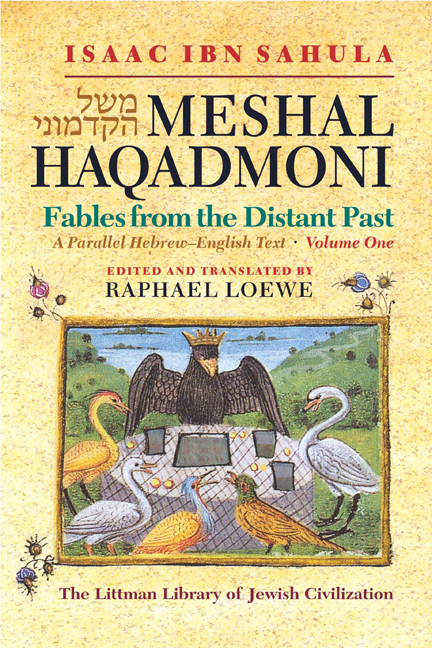Book contents
- Frontmatter
- Epigraph
- Publisher’s Note
- The Illustrations
- Preface
- Contents
- List of Abbreviations
- Introduction
- MESHAL HAQADMONI
- Part I On Wisdom
- Part II On Penitence
- Part III On Sound Counsel
- Part IV On Humility
- Part V On Reverence
- Appendices
- Bibliography
- Index of Citations
- Index of Key Hebrew Terms
- Index of Subjects
Appendix 1 - Astronomical Diagrams
- Frontmatter
- Epigraph
- Publisher’s Note
- The Illustrations
- Preface
- Contents
- List of Abbreviations
- Introduction
- MESHAL HAQADMONI
- Part I On Wisdom
- Part II On Penitence
- Part III On Sound Counsel
- Part IV On Humility
- Part V On Reverence
- Appendices
- Bibliography
- Index of Citations
- Index of Key Hebrew Terms
- Index of Subjects
Summary
The diagrams in the Rothschild manuscript (R, Israel Museum MS 180.51) correspond closely with the prescriptions for their construction in the text of the Meshal haqadmoni. They are reproduced here, followed in each case by a transcription of their markings into segments and of other matter inscribed on the face.
The Terrestrial Sphere and Climes
see V. 958 f.
In the four corners (clockwise, from top left) figures of the winds are labelled (‘SE corner’), (‘SW corner’), (‘NW corner’), (‘NE corner’).
1.2. The cardinal points are marked, clockwise, from the top (‘south’), (‘west’), (‘north’), (‘east’).
1.3. Each quadrant is subdivided at intervals of six degrees, being numbered from the east, anticlockwise:, similarly N–W, W–S, and S–E (90)–(6).
1.4. Two lines S and parallel to the (unmarked) equator read: (‘area of negro settlement [extends over] 16º, this [marking] the limit of human habitation in the south’). That information is repeated, in legends set at right angles to the foregoing, in four positions, reading anticlockwise from the west: 1. (‘width of southern settlement, viz. 16º’); 2. (‘uninhabited wasteland due to intensity of the sun’s(?) [heat]’); 3 repeats 2, and 4 repeats 1.
1.5. For the northern hemisphere the following legend is inscribed along the (unmarked) equator : (The line AB is the equator, comprising the length of the earth, day and night thereon being invariably equal: its total length is habitable’).
1.6. To the north of the equator eight lines detail the extent of successive climes, thus: 1. (‘This first clime inclines 16º from the equator, its longest day measuring 13 hours’); 2. (‘This second clime extends to 24º … 13½ hours’); thereafter this is abbreviated: 3. ‘31º … 14 hours’; 4. ‘36º … 14½ hours’; 5. ‘42º … 15 hours’; 6. ‘48º … 15½ hours’; 7. ‘52º … 16 hours’, and then continues (‘This is the northerly limit of human settlement, at 66º, the longest day being 24 hours in the land of night’).
- Type
- Chapter
- Information
- Meshal Haqadmoni: Fables from the Distant PastA Parallel Hebrew-English Text, pp. 727 - 734Publisher: Liverpool University PressPrint publication year: 2004

